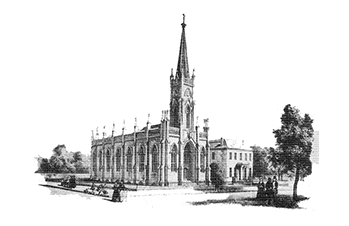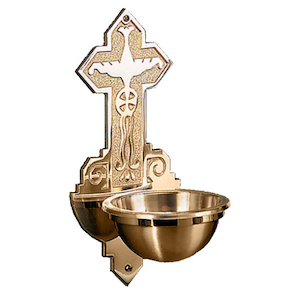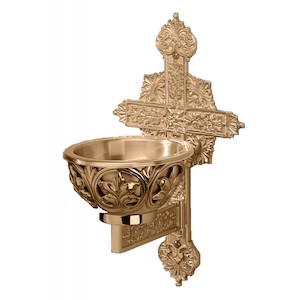History and usage of Holy Water
BY REV. DAVID O'CONNOR
Most Catholics are familiar with the practice of entering their church, dipping the finger(s) of their right hand in the font with holy water, and making the Sign of the Cross. Catholics repeat this ritual on leaving the church. The holy water in the font is holy only insofar as it has been blessed (or sanctified) by a priest. The water itself is not magic. Its power depends on the prayers, faith and devotion of the person who uses it. In making the Sign of the Cross with holy water, one expresses faith in God as Father, God as Son, and God as Holy Spirit and asks God's blessing in the name of the same three divine persons. This ritual action of blessing oneself also serves as a reminder of ones baptism.
Water, itself, has a long association with God's saving deeds. With water all things are washed and nourished. Water is life giving for all of nature and vegetation. Water flowed from the rock as God's gift to Old Testament people. The water of the Red Sea was divided to liberate God's people from slavery. Jesus was baptized in the waters of the Jordan. He came walking on the water to calm the storm on the Sea of Galilee. Ritual washings were required for the Jewish people before entering the temple; and, of course, this prefigured baptism.
In the theology of the Catholic Church, holy water is considered a sacramental ("little sacraments") as are crucifixes, medals, pictures of saints, rosaries, ashes and palms. Only when blessed are these to be thought of as holy. The Catholic Church also views as any holy candles, Bibles, ashes and palms that are blessed. All blessed objects are to be treated with reverence and respect; and when they are broken or damaged or no longer usable, they are to be disposed of by pouring into a special hand basin in the sacristy (sacrarium) or buried but never thrown into the garbage.
It is believed that the use of holy water dates to the first century, and even some sources relate its early usage to St. Matthew, although written documentation about its usage dates to the third or fourth century. In the Catholic Tradition, holy water is used for the purpose of baptisms, blessing of persons, places and objects, or as protection against evil and danger.
Holy water is also used by the priest to sprinkle the congregation during the entrance rite of the Mass. It is used by priests when blessing homes, animals, places of business, automobiles, and objects of devotion such as medals, rosaries, etc.
Holy water is usually found in fonts inside the doors of the church. Traditionally, Catholics have used holy water in their homes. They would get a small quantity from their church and have it for use in a font at their front or rear door, or at their bedroom doors. In their homes they would bless themselves as they would at church, and they would bless their children as they tucked them in at night, signing them with holy water on their foreheads. Ministers to the sick use holy water to bless the sick. At St. Mary Basilica, holy water is found in an urn in the sacristy. Don't be shy; ask for directions to find it.
Another type of holy water is that found in holy wells and at places associated with apparitions of Mary or saints, and at special holy sites - Lourdes, Fatima, etc.
Easter water is blessed at the Easter Vigil and is given a somewhat more solemn form of blessing (Easter candle is dipped in the water, drops of chrism) than "regular holy water". It is used for baptisms. Usually at St. Mary and Assumption churches, each family is given a small bottle of Easter water to use in their homes.
The next time you enter or leave a Catholic church, bless yourself and your children with holy water and begin the practice of doing this in your homes. Bless your home again and again, bless your children's bicycles, school books, computers, etc.


